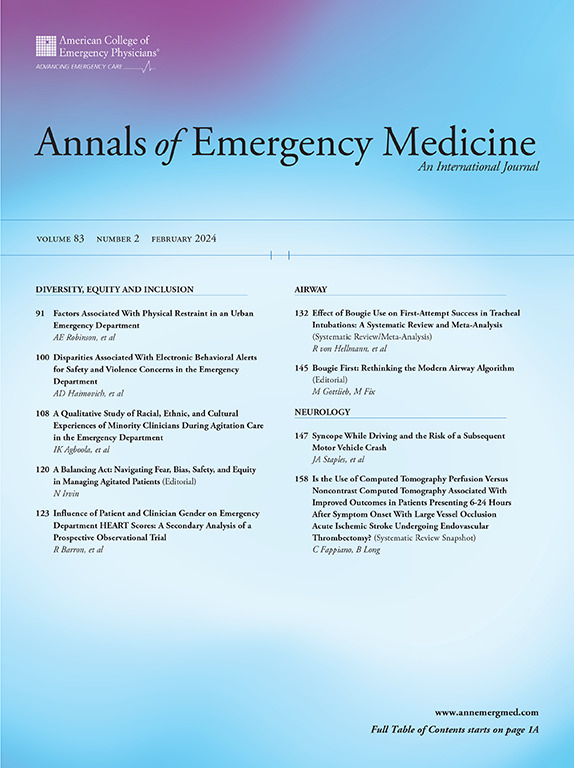Development of a New Screening Tool for Pediatric Septic Shock
IF 5
1区 医学
Q1 EMERGENCY MEDICINE
引用次数: 0
Abstract
Study objective
Existing screening tools for sepsis in children are limited by suboptimal sensitivity. Our objective was to develop a new, more sensitive screening tool for pediatric septic shock by enhancing 2 aspects of the 4-point Liverpool quick Sequential Organ Failure Assessment (LqSOFA) tool.
Methods
We performed a secondary analysis of a cohort of children (1 month to 18 years) who presented to a pediatric emergency department (ED) with suspected infection over a 10-year period. Septic shock was defined as intravenous vasoactive infusion within 24-hours of arrival for children with suspected infection and intravenous antibiotics administered. We developed the 4-point quick Pediatric Septic Shock Screening Score (qPS4) by making 2 changes to the 4-point LqSOFA: (1) the pulse rate parameter was replaced with the recently derived Temperature and Age-adjusted Mean Shock Index and (2) standard respiratory rate cutoffs for tachypnea were replaced by cutoffs derived empirically from the study cohort. The other 2 LqSOFA criteria were unchanged (abnormal mentation and capillary refill ≥3 seconds). We defined a positive qPS4 as ≥2 criteria (consistent with LqSOFA). We used the training cohort from the parent study to derive cutoffs for respiratory rate and the validation cohort to compare the qPS4 with LqSOFA and qSOFA.
Results
Among the 47,231 encounters in the validation cohort from the parent study, with median age of 4.5 years, qPS4 had an area under the receiver operating characteristic curve for septic shock of 0.94 (95% confidence interval [CI] 0.92 to 0.96). qPS4 ≥2 had a sensitivity of 89.7% (95% CI 84.9% to 94.5%), and a specificity of 92.2% (95% CI 92.0% to 92.5%) for septic shock. In comparison, the LqSOFA achieved an area under the receiver operating characteristic curve of 0.86 (95% CI 0.82 to 0.89), a sensitivity of 56.1% (95% CI 48.3% to 63.9%), and a specificity of 96.8% (95% CI 96.6% to 96.9%). The median time from first positive qPS4 to initiation of an intravenous vasoactive infusion was 2.5 hours (IQR 0.9 to 6.1) compared to 0.7 hours (IQR 0.0 to 4.5) for LqSOFA.
Conclusion
The qPS4, with 2 enhancements to the LqSOFA, demonstrated overall improved sensitivity and specificity for pediatric septic shock.
开发新的儿科败血症休克筛查工具。
研究目的现有的儿童脓毒症筛查工具因灵敏度不够而受到限制。我们的目标是通过增强利物浦快速器官功能衰竭评估(LqSOFA)四点工具的两个方面,开发出一种新的、更灵敏的小儿脓毒性休克筛查工具:我们对 10 年间因疑似感染而到儿科急诊室(ED)就诊的一组儿童(1 个月至 18 岁)进行了二次分析。脓毒性休克的定义是:疑似感染患儿在到达后 24 小时内静脉输注血管活性药物并静脉注射抗生素。我们对 4 分 LqSOFA 进行了两处修改,从而制定了 4 分快速儿科脓毒性休克筛查评分(qPS4):(1) 用最近得出的体温和年龄调整后平均休克指数取代脉搏参数;(2) 用研究队列中经验得出的临界值取代呼吸急促的标准呼吸频率临界值。其他 2 项 LqSOFA 标准保持不变(精神异常和毛细血管再充盈时间≥3 秒)。我们将 qPS4 阳性定义为≥2 项标准(与 LqSOFA 一致)。我们利用母研究的训练队列得出呼吸频率的临界值,并利用验证队列将 qPS4 与 LqSOFA 和 qSOFA 进行比较:qPS4 ≥2对脓毒性休克的敏感性为89.7%(95% CI为84.9%至94.5%),特异性为92.2%(95% CI为92.0%至92.5%)。相比之下,LqSOFA 的接收者操作特征曲线下面积为 0.86(95% CI 0.82 至 0.89),灵敏度为 56.1%(95% CI 48.3% 至 63.9%),特异性为 96.8%(95% CI 96.6% 至 96.9%)。从 qPS4 首次阳性到开始静脉输注血管活性药物的中位时间为 2.5 小时(IQR 0.9 至 6.1),而 LqSOFA 为 0.7 小时(IQR 0.0 至 4.5):结论:qPS4对LqSOFA进行了两项改进,在整体上提高了小儿脓毒性休克的敏感性和特异性。
本文章由计算机程序翻译,如有差异,请以英文原文为准。
求助全文
约1分钟内获得全文
求助全文
来源期刊

Annals of emergency medicine
医学-急救医学
CiteScore
8.30
自引率
4.80%
发文量
819
审稿时长
20 days
期刊介绍:
Annals of Emergency Medicine, the official journal of the American College of Emergency Physicians, is an international, peer-reviewed journal dedicated to improving the quality of care by publishing the highest quality science for emergency medicine and related medical specialties. Annals publishes original research, clinical reports, opinion, and educational information related to the practice, teaching, and research of emergency medicine. In addition to general emergency medicine topics, Annals regularly publishes articles on out-of-hospital emergency medical services, pediatric emergency medicine, injury and disease prevention, health policy and ethics, disaster management, toxicology, and related topics.
 求助内容:
求助内容: 应助结果提醒方式:
应助结果提醒方式:


